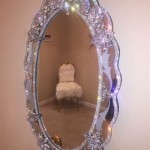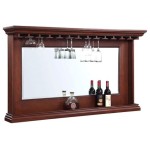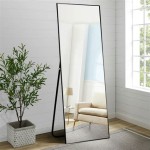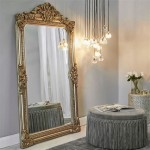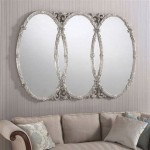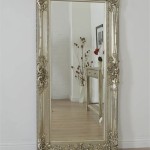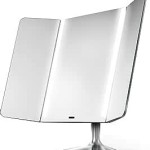How To Hang a Heavy Framed Bathroom Mirror
Hanging a heavy framed bathroom mirror requires careful planning and execution to ensure both safety and stability. Choosing the correct hanging method and hardware is crucial to prevent the mirror from falling and causing damage or injury.
Assessment and Preparation: Begin by accurately measuring the mirror's dimensions and weight. This information is essential for selecting appropriate hardware. Inspect the back of the framed mirror for existing hanging hardware, such as D-rings, wire, or cleats. If no hardware is present, it will need to be installed. The wall type also plays a significant role in determining the best hanging method. Drywall requires different fasteners than concrete or tile.
Choosing the Right Hardware: Heavy mirrors necessitate robust hanging hardware. For mirrors weighing less than 50 pounds, heavy-duty picture hangers rated for the mirror's weight can be sufficient. However, for mirrors exceeding 50 pounds, it is recommended to use two or more D-rings attached to the frame and corresponding wall anchors. These anchors should be specifically designed for the wall type and rated to hold a weight significantly exceeding that of the mirror. Toggle bolts are ideal for drywall, while concrete screws or masonry anchors are suitable for concrete or tile walls. Wire should be avoided for very heavy mirrors, as it can stretch and potentially cause the mirror to become unstable.
Locating Studs: Whenever possible, hanging heavy objects on wall studs provides the most secure mounting. Use a stud finder to locate the studs behind the intended hanging location. Mark the stud locations with a pencil. If the desired placement doesn't align with wall studs, the use of appropriate wall anchors is mandatory.
Installing D-Rings: If the mirror doesn't have D-rings, install them on the back of the frame. Measure and mark two points equidistant from the center of the frame's top edge, ensuring the D-rings are positioned to distribute the weight evenly. Securely attach the D-rings using screws appropriate for the frame material. Ensure the screws are long enough to bite firmly into the frame but not so long as to protrude through the front.
Marking Wall Anchor Locations: Hold the mirror against the wall in the desired position. Using a level, ensure the mirror is straight. With a pencil, mark the locations where the D-rings align with the wall. If using wall studs, ensure these marks fall on the center of the studs. If using wall anchors, ensure sufficient spacing between the anchors for proper weight distribution.
Installing Wall Anchors or Drilling Pilot Holes: If using wall anchors, follow the manufacturer's instructions for installation. Different anchor types have specific installation procedures. For stud mounting, pre-drill pilot holes slightly smaller than the diameter of the screws to be used. This prevents the wood from splitting and ensures a secure hold.
Hanging the Mirror: Carefully lift the mirror and align the D-rings with the installed wall anchors or screws. Slowly lower the mirror onto the hardware, ensuring it's securely in place. Use the level again to verify the mirror remains straight. Once satisfied with the placement, gently tug on the frame to confirm its stability.
Safety Precautions: When handling heavy mirrors, it is advisable to have a second person assist. Wear appropriate safety gloves to protect hands from sharp edges and splinters. Eye protection is also recommended, especially when drilling. If unsure about any aspect of the installation process, consult a qualified professional. Proper installation ensures the safety and longevity of the mirror installation.
Tools and Materials: Gather necessary tools and materials beforehand. These may include a measuring tape, pencil, level, stud finder, drill with appropriate drill bits, screwdriver, safety gloves, eye protection, wall anchors (if required), D-rings (if required), screws, and a hammer.
Mirror Placement Considerations: Consider the surrounding environment when positioning the mirror. Avoid placing it in direct sunlight, which can damage the frame and reflective surface over time. Also, consider the height of users to ensure optimal reflection. The mirror's center should ideally be at eye level for the average user.
Post-Installation Inspection: Regularly inspect the mirror and its hanging hardware for any signs of loosening or damage. Tighten screws or replace worn hardware as needed to maintain a secure and safe installation. Addressing potential issues promptly prevents accidents and prolongs the lifespan of the mirror.
Alternative Hanging Methods: For extremely heavy mirrors, consider alternative hanging methods such as French cleats or mirror mounting clips. These systems provide a more robust and evenly distributed support structure. Consult with a professional for guidance on selecting and installing these specialized hanging systems.

How To Hang A Heavy Mirror Diy Family Handyman

How To Hang A Large Or Heavy Mirror

How To Frame A Mirror

Mirror Frame Diy How To Update A Basic Bathroom Our Faux Farmhouse

How To Hang A Heavy Mirror Or Picture True Value

How To Pick And Hang The Perfect Bathroom Mirror Roomhints

Diy Bathroom Mirror Frame Without Removing Clips Her Happy Home

Mirror Frame Diy How To Update A Basic Bathroom Our Faux Farmhouse

How To Hang A Frameless Mirror On The Wall With Pictures

How To Frame Out That Builder Basic Bathroom Mirror For 20 Or Less

